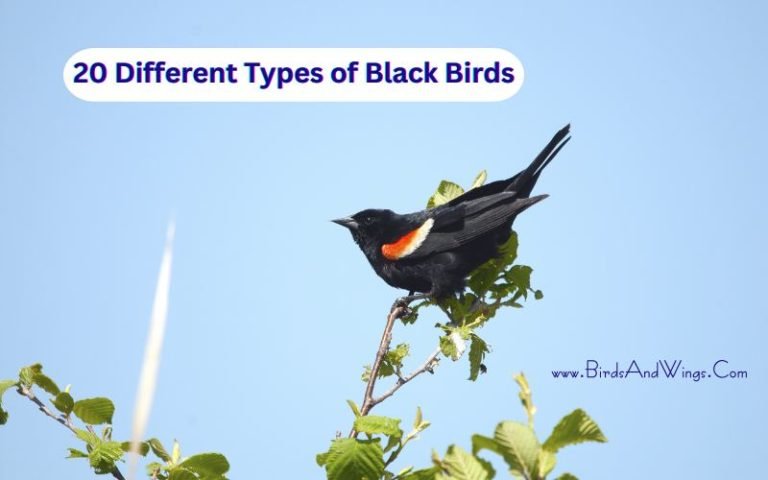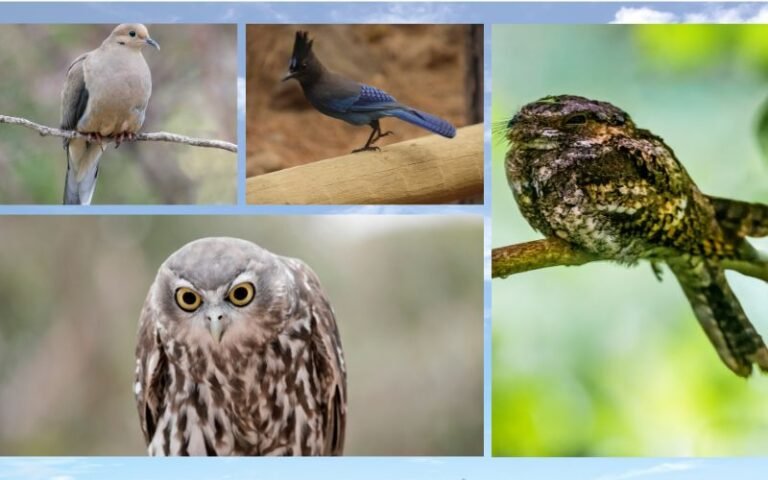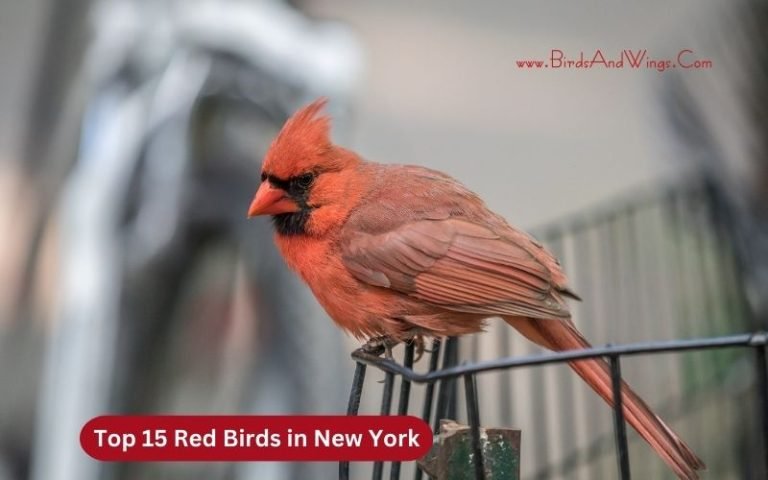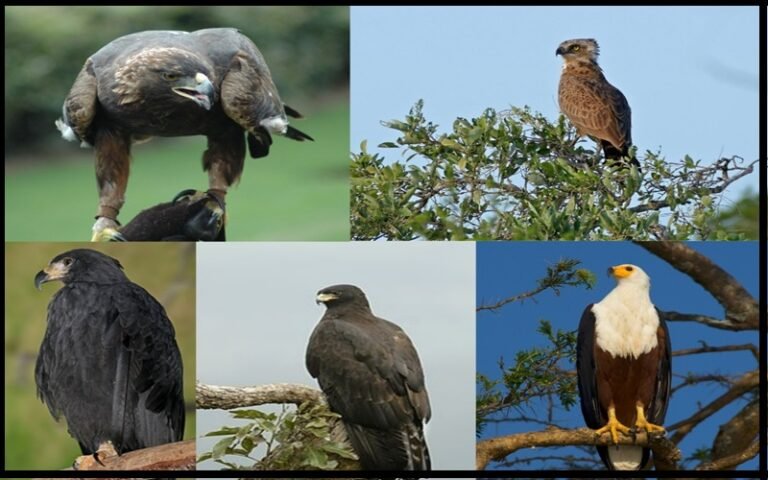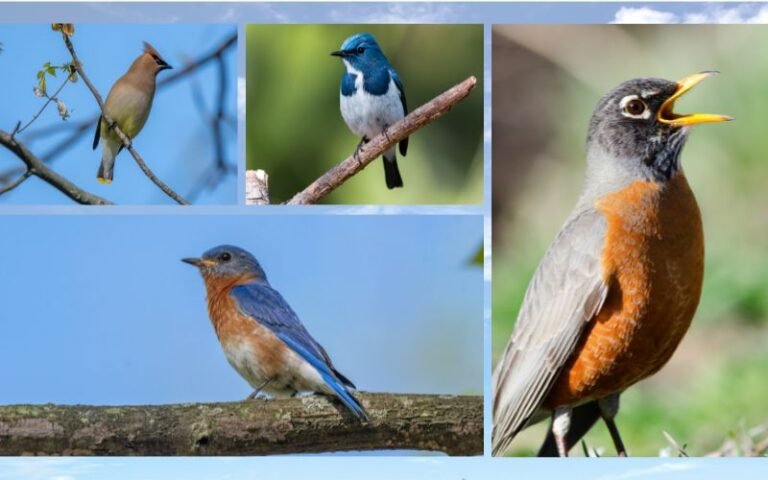15 Small Birds With Red Head
Red has always fascinated and charmed humans with its royal entity. If this red color is in birds, it looks more prominent on them, giving them distinguished and notable appearances among humans.
This article will discuss small birds with redheads, which makes their appearances stand out among human beings.
It will also discuss their physical characteristics, such as their scientific names, lifespan, wingspan, size, native place, food, and other facts. So, Let’s jump into the prominent red worlds of birds.
15 Small Birds With Red Head
This section will briefly describe each red bird, including their physical characteristics such as their scientific names, size, wingspan, and geographic distribution, along with their native places, habitat preferences, feeding habits, and other attributes of nature.
Bird 1: Northern Cardinal

- Scientific name: Cardinalis cardinalis
- Lifespan: around 15 years
- Wingspan: 25–31 cm (9.8–12.2 in)
- Native to: Southeastern Canada, Eastern United States
- Size: around 21 to 23 cm
- Food or Diet: seeds, grains, fruits, snails, oats, grasshoppers, etc.
Northern cardinals, also known as red birds, common cardinals, or red cardinals, are subspecies of the Cardinal family.
These species’ whole bodies are covered with red plumage with a red crest on their head. Their faces are black around the eyes and nose area with bright red beaks.
Female cardinal birds are slightly reddish olive in color. These northern cardinals are widely common in the United States, including Florida, Canada, New Mexico, Texas, Guatemala, and Bermuda.
These species often prefer open wooded areas, wetlands, parks, and brushy fields for their habitats. Their diet contains 90% of seeds and fruits.
These Northern cardinals make their pairs for several years, but if one partner dies, then again they look for another partner.
They perform display dance while representing bonding behavior during their courtship days. In these courtship rituals, male cardinals bring food for the female cardinals and sometimes feed their partner from beak to beak.
They build their nests with twigs, strips, grasses, or plant fibers. Female cardinals usually lay 3 to 4 eggs in the nests and female cardinals incubate those eggs for 12 to 13 days. Little chicks use their vocals to attract their parents when they are hungry.
Bird 2: Red-Headed Woodpecker

- Scientific name: Melanerpes erythrocephalus
- Lifespan: maximum longevity of 9.9 years
- Wingspans: 16.7 inches
- Native to: North America
- Size: 19 to 25 cm
- Food or Diet: seeds, nuts, berries, fruits, insects, etc.
Red-headed woodpeckers are medium-sized birds with black backs and tails and white breasts and belly. They have bright red heads and black beaks.
These species are mostly spotted in North America, including southern Canada and the East Central United States. These woodpeckers store their food in their tree cavities, a habit only found in two to three species, including this red-headed woodpecker.
They stuff food into their tree holes or cavities, which helps them survive throughout the years. These species remain with their partner for several breeding seasons.
After building their nests, these woodpeckers become territorial and try to protect their territory. Sometimes, they also destroy other birds’ eggs and territories.
Female birds choose their nesting cavity, and sometimes, both male and female woodpeckers drill trees to make their own nesting cavities. However, most of the drilling is done by the male woodpeckers.
Female woodpecker birds lay 4 to 7 white eggs and incubate them for 2 weeks, usually, at around 27 to 31 days after the young fledge from their nests.
Bird 3: House Finch

- Scientific name: Haemorhous Mexacanus
- Lifespan: around 11 years
- Wingspan: 8 – 10 inches
- Native to: North America
- Size: 12 to 15 cm
- Food or Diet: seeds, buds, fruits, plants, etc.
House Finch are small birds that are related to the Finch family. Male finches have nut-brownish bodies with a red patch on their face and chin.
Female finch birds have brownish bodies with white spots. These house finch birds are widely familiar in North America, including New York, Mexico, the southwestern United States, and Canada.
These species tend to choose semi-open, urban, and suburban places for their habitats. Besides, these species build their nests in cavities in open buildings, hanging plants, or other cup-shaped outdoor decors.
House finches made their nests in cavities. Sometimes, they even used a nest that was abandoned by other birds. During their courtship rituals, female and male birds touch themselves with their bills.
Sometimes, the male finch brings food for his mates and feeds them; even when female birds incubate, male birds feed them at that time.
Female birds build their nests about 1.8 to 2.7 meters above the ground. Female finches lay 2 to 6 eggs and incubate them for 12 to 14 days until they hatch.
These House finches birds are considered one of the most annoying birds because they destroy orchards, fruits, and grain fields.
Bird 4: Summer Tanager

- Scientific name: Piranga rubra
- Lifespan: around 5 years
- Wingspan: 28 to 30 cm
- Native to: Southern states, Mexico, Central America, and South America
- Size: 17 cm (6.7 in)
- Food or Diet: prime food insects, beetles, cicadas, caterpillars, grasshoppers, bugs, flies and spiders
Summer tanagers are also classified in the Cardinalidae family. Here, the adult male tanagers have rose-red plumage and a dark bill.
Female birds have orangish underneath and olive upper parts, with olive-brown wings and tails. These species are mostly common in the southern United States, Mexico, Central America, and South America.
However, these species are rarely visited or found in Western European countries. They tend to choose wooded areas, mostly oaks for their habitats.
During winter, they live in places like lowlands, forest edges, and scattered trees. They sometimes forage in high trees to catch their food and even fly out to catch insects. These summer tanagers birds make pi-tuk or pik-i-tuk vocals to communicate.
Bird 5: Scarlet Tanager

- Scientific name: Piranga olivacea
- Lifespan: around 10-12 years
- Wingspan: 25 to 30 cm (9.8 to 11.8 in)
- Native to: Eastern North America, South America
- Size: 16 to 19 cm (6.3 to 7.5 in)
- Food or Diet: mainly insects, wasps, bees, ants, snails, worms and some fruits
Scarlet Tanagers are a similar subspecies of tanager birds belonging to the Cardinalidae family. Both female and male tanagers have smoothing bills of a pale color.
Adult male tanagers have deep red plumage and black on the wings which almost resemble northern cardinals and summer tanagers. Female tanagers have olive-yellowish plumage with brownish wings.
These summer tanager species inhabit deciduous forests, oak trees, parks, suburban areas, and cemeteries in the North American region.
They reach their breeding spot between May and early June. Female tanager birds reach their breeding spots several days later. Later, females build nests and lay four eggs in a light blue color.
After laying the eggs, female birds incubate the eggs for about 11 to 14 days. The young birds leave their nest by 9 to 12 days and can fly fully after being hatched.
Sometimes, they fly around to catch their prey, and they are even spotted on the forest grounds or floor in order to search for food.
Bird 6: Red-Headed Tanager

- Scientific name: Piranga erythrocephala
- Lifespan: not found
- Wingspan: not found
- Native to: Mexico
- Size: 15 cm (5.9 in)
- Food or Diet: insects and fruits
Red-headed tanager birds also belong to the Cardinalidae family. The tanager’s head, face, throat, and upper chest are red, and the rest of the body is olive brownish.
Their lower parts are slightly yellowish-olive in color. The female’s head is yellowish, and the other parts are yellow-olive.
These red-headed tanagers are local to Mexico City, Oaxaca, southern Sonora, and Chihuahua, south of Jalisco.
These species prefer wooded areas, open woodlands, semi-humid and moist montane forests, pike oak forests, and evergreen forests as their habitats.
Red-headed tanagers can fly up to 900-2600 m ( 3000- 8500 ft) above the surface.
Bird 7: Western Tanager

- Scientific name: Piranga ludoviciana
- Lifespan: around 8 years; 15 years in captivity
- Wingspan: 11.5 in (29 cm)
- Native to: America; north, south, and central
- Size: 6.3-7.5 in (16-19 cm)
- Food or Diet: fruits, berries, insects
Western tanager birds are the subspecies of tanager birds also related to the Cardinalidae family. Adult males have reddish-yellow heads with black upperparts and yellow underparts.
Their beaks are pale, stout, and pointed, with light wing bars. Female tanagers have a yellow head, olive body, and dark wings and tails.
These species’ breeding range cover North America, southeastern Alaska, north Baja California, Mexico, western Texas, and central New Mexico.
Western tanager birds prefer open coniferous forests, mixed woodlands, deserts, oases, parks, and orchards for their habitats.
Sometimes, western tanagers migrate alone, or they may form a group of 30 birds. Generally, their migration period starts in the middle of August.
They build their nests around 10 feet higher than ground level. Female tanagers make their nests mostly cup-shaped.
Bird 8: Purple Finch

- Scientific name: Haemorhous purpureus
- Lifespan: around 7 years
- Wingspan: 25.4 cm
- Native to: North America
- Size: 12 -16 cm
- Food or Diet: ground vegetation, fruits, seeds, berries and insects
Purple Finch birds are beautiful small birds with red and white plumage over their body. Around the forehead and head parts, the red color is more prominent.
Their eyes are also covered with white lines. These species are native to North America, including Canada, the United States, and the Pacific coasts.
Some birds migrate from northern Canada to the southern United States, and other birds permanently stay in their own regions for all seasons.
They build their nests in a tree’s fork or horizontal branch. They mostly eat what they find on the grounds.
However, their prime food is seeds, along with berries, sunflowers, millet, and insects. These species try to avoid human interaction and contact.
Bird 9: Red Faced Warbler

- Scientific name: Cardellina rubrifrons
- Lifespan: not found
- Wingspan: 8.3 inches (21 cm)
- Native to: Mexico, Arizona, New Mexico
- Size: around 14 cm
- Food or diet: caterpillars, flies, aphids, leafhoppers etc.
The red-faced warbler bird is related to the New World warbler species group. They have light gray plumage on their upper side with a white rump.
Besides, they have bright red on their face, neck, and upper breast with a black crown patch on their head. These red-faced warblers are local to Mexico, Arizona, and New Mexico.
In the summertime, they are spotted in northern Mexico, including the states of Arizona and New Mexico. Later in winter, they migrate to southern Mexico and Central America, including EI Salvador, Guatemala, and Honduras.
Besides, they choose mountain forests with conifers and oak trees as their habitats. These conifers and oak trees grow up to 2000 to 3000 m (6600- 9800 feet) above sea surface level.
Here, Female birds build small cup nests with leaves, grass, and pine needles. They also hide their nests on the forest floor, bury them, or cover them with a shrub, log, or rock.
The female red-faced warbler lays 3 to 5 white brown eggs with a white spot on them. Later they incubate the eggs for up to 12 days until the eggs hatch.
Bird 10: Vermilion Flycatcher

- Scientific name: Pyrocephalus obscurus
- Lifespan: around 4 to 5 years
- Native to: South America and North America
- Size: 13 to 14 cm
- Food or Diet: insects such as flies, grasshoppers, spiders, beetles, etc.
Vermilion flycatchers are small passerine birds related to the flycatcher species family. Their bodies have red and brown plumage on the wings.
They also have little crests above their heads and raise them when needed. They are mostly familiar in Mexico, the United States, and Central America.
They prefer woodlands, open areas, shrublands, and savanna lands, usually near the water, for their habitats. These flycatchers molt or shed their wings in 62 to 79 days.
This process generally begins in July and lasts till September. They sing single songs for perching and their different songs and vocals might refer to their different intentions and events.
These Vermilion flycatchers form small groups or flocks of five or six birds. During their breeding seasons, male birds defend their territory more aggressively and show their aggressiveness by raising their crests and tails to intruders or other birds.
Bird 11: Pyrrhuloxia

- Scientific name: Cardinalis sinuatus
- Lifespan: up to 9 years
- Wingspan: 10-12 inches ( 25-31 cm)
- Native to: North America
- Size: 8.3 in (21 cm)
- Food or Diet: seeds, fruits, and insects
Pyrrhuloxia is a medium-sized cardinal that resembles northern and Vermilion cardinals. The male Pyrrhuloxia is brownish-gray with a red crest on its head.
Their faces are also red, and their beaks are orange. These birds are mostly found in the North American region, including the American Southwest, Northern Mexico, the United States of Arizona, and Texas.
Their preferred habitats are desert scrub, mesquite thickets, and woodland areas. This species’ breeding season starts in mid-March and ends in mid-August.
During their breeding seasons, male birds establish their territories and defend them. Male pyrrhuloxia generally defend their territories by chasing away any intruders. They also sing a song to divert the concentration of predators or intruders.
Females make their nests, which are bowl or cup-shaped and generally made with grass, tree leaves, bark, plants, and twigs. Later, female birds lay 2 to 4 eggs there and incubate for about 2 weeks.
Bird 13: Red-Bellied Woodpecker

- Scientific name: Melanerpes carolinus
- Lifespan: around 12 years
- Native to: Eastern United States including Florida and Canada
- Size: 22.85 to 26.7 cm
- Food or Diet: beetles, centipedes, spiders, fruits, and other insects
The Red-Bellied woodpecker is a medium-sized woodpecker with similar subspecies to the woodpecker family. They are mostly spotted in the eastern United States, including South Florida and North Canada.
Some might confuse them with red-headed woodpeckers, but their red patch on the head and zebra-patterned black and white stripes in the wings define their identity.
These birds are mostly noisy and create lots of chur-chur-chur sounds which shows they are trying to call other groups or pairs to communicate.
Sometimes, they tap on hollow trees or aluminum roofs to make a sound. These woodpeckers can catch their prey or any other insects in flight positions.
These red-bellied woodpeckers prefer dead or dry wood for their nesting purposes. Male birds seek the permission of their mates and tap their nesting holes mutually.
Bird 14: Pine Grosbeak

- Scientific name: Pinicola enucleator
- Lifespan: around 9.8 years.
- Wingspan: 13 inches
- Native to: Northern Eurasia, North America, Canada the United States
- Size: 20 to 25.5 cm
- Food or diet: seeds, buds, berries, and insects
Pine grosbeaks are a similar species of the Finch family, related to the Fringillidae group. They have red and black plumage over their bodies, with a redhead, face, back, and rump.
Their wings and tails are black, along with white wing bars and large beaks. These birds are local to Alaska, the United States, and Canada, inhabiting wooded areas, coniferous forests, and western mountains.
In Europe and North America, these birds, including coniferous forests, are mainly spotted for their breeding procedures. Female birds make horizontal nests on a brochure or in a fork of a conifer tree.
If they lack food sources, they might migrate to the South to search for food. These birds are also spotted in flocks apart from their nesting seasons.
Bird 15: Red-Breasted Sapsucker

- Scientific name: Sphyrapicus ruber
- Lifespan: around 4 to 5 years
- Wingspan: 37 to 40.6 cm
- Native to: North America
- Size: 20 to 22 cm
- Food or diet: insects, tree sap, and fruits
Red-breasted sapsuckers are medium-sized woodpeckers that are familiar in mostly North America. They have red heads and upper chests, with a white lower belly and rump.
Red-breasted sapsuckers are native to North America, including southeast Alaska, British Columbia, the Pacific Coast Range, Washington, and California. Their backs are black, and their wings have white wing bars.
They are also fond of forests with one hemlock and Douglas-fir woodlands. Some species also prefer old-growth forest areas for their habitats.
They collect sap from the loving trees which is their primary diet. These birds make nests in cavities and mostly prefer dead trees and deciduous trees to create holes in.
However, they do not reuse their nest cavities; rather, they prefer creating new cavities every season. In the nests, the female red-breasted sapsucker lays 4 to 7 pure white eggs and incubates them.
Later both parents feed the young until they leave the nests.
Conclusion
In short, as discussed in this article, these 15 small birds with redheads have prominent red appearances that enhance their look even more worldwide.
Similarly, purple birds, bluebirds, black birds with yellow beaks, and Yellow birds with black wings equally have that prestige and influential impression on the human world.
These birds’ outlook, physical features, characteristics, and adaptability flabbergasted humans or any bird observer.



